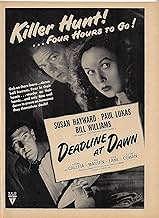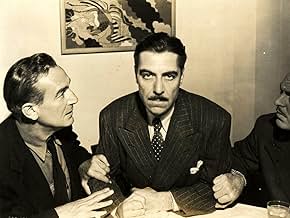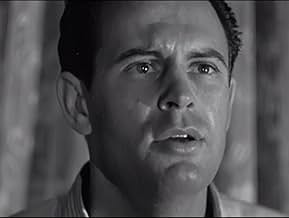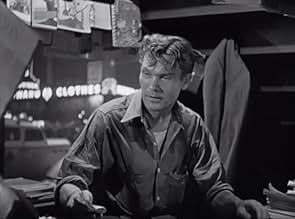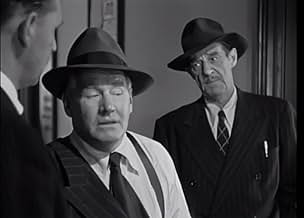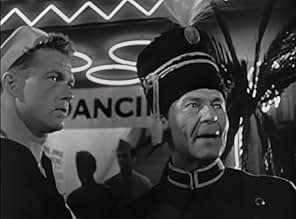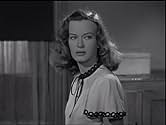AVALIAÇÃO DA IMDb
6,8/10
2,5 mil
SUA AVALIAÇÃO
Adicionar um enredo no seu idiomaAfter a woman he meets is murdered, a soon-to-ship-out sailor has until dawn to find the killer, aided by a weary dance hall girl.After a woman he meets is murdered, a soon-to-ship-out sailor has until dawn to find the killer, aided by a weary dance hall girl.After a woman he meets is murdered, a soon-to-ship-out sailor has until dawn to find the killer, aided by a weary dance hall girl.
- Direção
- Roteiristas
- Artistas
- Prêmios
- 1 indicação no total
Ernie Adams
- Waiter
- (não creditado)
Fred Aldrich
- Beefy Nightclub Guest
- (não creditado)
Walter Bacon
- Commuter
- (não creditado)
John Barton
- One-Legged Man
- (não creditado)
Billy Bletcher
- Waiter
- (não creditado)
- Direção
- Roteiristas
- Elenco e equipe completos
- Produção, bilheteria e muito mais no IMDbPro
Avaliações em destaque
When a blind ex-husband wearing a boutonnière shows up late in the evening demanding $1400, a good night is probably not in store. Especially when his former spouse's drunken excuse for not paying is "that sailor" must have stolen it. Thus begins Deadline at Dawn, an early noir that's not only a taut and agreeably complicated little mystery but that also aspires, and largely succeeds, in constructing an urban microcosm.
The sailor (Bill Williams) on shore leave has, as sailors on leave do, drunk too much, gambled away his money, been lured up to a wicked woman's apartment, and fallen into a blackout. (The movie's based on a novel by Cornell Woolrich, writing as William Irish, who knew whereof he wrote.) When he climbs back out, thanks to black coffee supplied by a kindly newsie, $1400 tumbles out of his pocket.
Trying to piece together the evening, he strays into a dime-a-dance palace, where he meets a would-be hard case (Susan Hayward in her 24th movie!). Making small talk with his bored-to-the-bone partner, Williams speculates whether a rainstorm might break the heat wave. "Such things have been known to happen," replies Hayward, thereby lowering the thermometer pronto. (The quirky, bristling dialogue by Clifford Odets is one of the many amenities of Deadline at Dawn.) Of course, Hayward inevitably thaws enough to offer counsel to Williams and serve as sidekick in his quest to make amends (he's a square-rigger right out of one of the square states). They return to the robbed woman's apartment only to find her (Lola Lane) dead. It's unclear to the befuddled Williams, and to Hayward, whether he might indeed have been the culprit. Trouble is, he's taking a 6 a.m. bus back to Norfolk, where he's stationed; there's only a few hours left to clear his conscience or fess up to the police.
An immigrant cabbie (Paul Lukas) improbably volunteers as a third ally, and the three, together and separately, embark on various sleuthing expeditions through the dark and soupy streets of Manhattan. For a movie that clocks in under an hour and a half, Deadline at Dawn boasts a cast just short of epic. Among the principals who intersect are Joseph Calleia, as a ruthless yet debonair gangster; Osa Massen as a lame housewife expelled from the rubble of Europe; and Steven Geray as a well-mannered stalker. Joining them are countless players with brief walk-ons, comic or poignant, of the 8-million-stories-in-the-naked-city variety, giving the movie the sole directorial effort by east-coast theater maven Harold Clurman its distinctive tone and texture. (Jules Dassin must have borrowed greedily from it when he came to film his own The Naked City during the sweltering New York summer of 1947.) Deadline at Dawn falls short of perfection. It's too short for all it contains, it's a bit sooty from all the red herrings, and its way out verges on the-butler-did-it (or maybe Roger Ackroyd). But a lot of RKO talent went into its making (in addition to the above, Nicholas Musuraca photographed it, and Hanns Eisler later to become a serious Leftist composer in East Germany wrote the score). But it has its own sweaty, big-city flavor, a pungent New York Story, and a prototype of many noirish delights yet to come.
The sailor (Bill Williams) on shore leave has, as sailors on leave do, drunk too much, gambled away his money, been lured up to a wicked woman's apartment, and fallen into a blackout. (The movie's based on a novel by Cornell Woolrich, writing as William Irish, who knew whereof he wrote.) When he climbs back out, thanks to black coffee supplied by a kindly newsie, $1400 tumbles out of his pocket.
Trying to piece together the evening, he strays into a dime-a-dance palace, where he meets a would-be hard case (Susan Hayward in her 24th movie!). Making small talk with his bored-to-the-bone partner, Williams speculates whether a rainstorm might break the heat wave. "Such things have been known to happen," replies Hayward, thereby lowering the thermometer pronto. (The quirky, bristling dialogue by Clifford Odets is one of the many amenities of Deadline at Dawn.) Of course, Hayward inevitably thaws enough to offer counsel to Williams and serve as sidekick in his quest to make amends (he's a square-rigger right out of one of the square states). They return to the robbed woman's apartment only to find her (Lola Lane) dead. It's unclear to the befuddled Williams, and to Hayward, whether he might indeed have been the culprit. Trouble is, he's taking a 6 a.m. bus back to Norfolk, where he's stationed; there's only a few hours left to clear his conscience or fess up to the police.
An immigrant cabbie (Paul Lukas) improbably volunteers as a third ally, and the three, together and separately, embark on various sleuthing expeditions through the dark and soupy streets of Manhattan. For a movie that clocks in under an hour and a half, Deadline at Dawn boasts a cast just short of epic. Among the principals who intersect are Joseph Calleia, as a ruthless yet debonair gangster; Osa Massen as a lame housewife expelled from the rubble of Europe; and Steven Geray as a well-mannered stalker. Joining them are countless players with brief walk-ons, comic or poignant, of the 8-million-stories-in-the-naked-city variety, giving the movie the sole directorial effort by east-coast theater maven Harold Clurman its distinctive tone and texture. (Jules Dassin must have borrowed greedily from it when he came to film his own The Naked City during the sweltering New York summer of 1947.) Deadline at Dawn falls short of perfection. It's too short for all it contains, it's a bit sooty from all the red herrings, and its way out verges on the-butler-did-it (or maybe Roger Ackroyd). But a lot of RKO talent went into its making (in addition to the above, Nicholas Musuraca photographed it, and Hanns Eisler later to become a serious Leftist composer in East Germany wrote the score). But it has its own sweaty, big-city flavor, a pungent New York Story, and a prototype of many noirish delights yet to come.
It is a shame that this is an all but forgotten example of Film Noir. Hopefully it will make a comeback. A sailor has apparently killed someone and has until dawn to find the real killer. Bill Williams, sort of a poor man's Lloyd Bridges, is serviceable as the sailor. But stealing the entire film and dominating the plot is a wonderful Susan Hayward, who somehow manages to be beautiful, sexy, and tough as nails as she in effect plays a hard-bitten private detective tracking down the truth. I would have loved to have seen Hayward, as a female, play one of those 1940's private eyes, or try her hand at the Stanwyck role in "Double Indemnity". But she's good enough here. If you spot this movie, SEE it. Hayward makes a good movie even better.
A young sailor on leave wakes up at midnight in a newsstand with bundles of money in his pockets and no recollection of his time spent with the wrong woman. Of course she turns out to be dead and he has until a bus leaves at 6am to discover the culprit or he gets the rap.
I like films with concentrated wandering, this one has it, the entire film like a slow ride across New York after hours in the backseat of a cab with windows rolled down, it's the middle of August, the macadam breathing out the day's heat again, or like lounging by the open window of your apartment with lights turned off, glimpses of strange figures stalking the empty and sweltering streets below and imagining mischief from them.
It has mood above all, latenight paranoia being sweated out from pores in the skin. Everything looks a bit unhinged in that magic-desolate way that is summer in the big city.
But this is deeply noirish in a key way, the way of the dumb guy's dream that crystallizes the essence of noir. Our man was out at night dreaming but has no recollection what about, except it involved offers of sex and illicit money. We presume he's innocent because of his naive blond looks and because he's the one telling the story, and is bewildered as he does, because more likely suspects are paraded, stories are piled, testimonies, conjecture, a drunk man uncovers hidden truth, a cab driver reflects about love, but the puzzle persists, the puzzle that is the night of life; we cannot really know, there is a blank spot at the center. Emptiness behind the stories that we make up to narrate our private worlds.
You will need no more eloquent parallel about what this is all about than a blind pianist among the suspects and being - mistakenly - sussed from his melodramatic reaction.
So we have sinister happenings back in the waking world, itself rendered as something you wake up from. Then our film as a dream attempting inner balance, so of course thick in coincidence, in strange but kind souls assisting, capped off with a miraculous revelation in the end that absolves guilt.
This is truly wonderful stuff that has burned itself into my visual imagination. It's clean and dark both, the shadows all in having traveled, having dreamed the night away.
I like films with concentrated wandering, this one has it, the entire film like a slow ride across New York after hours in the backseat of a cab with windows rolled down, it's the middle of August, the macadam breathing out the day's heat again, or like lounging by the open window of your apartment with lights turned off, glimpses of strange figures stalking the empty and sweltering streets below and imagining mischief from them.
It has mood above all, latenight paranoia being sweated out from pores in the skin. Everything looks a bit unhinged in that magic-desolate way that is summer in the big city.
But this is deeply noirish in a key way, the way of the dumb guy's dream that crystallizes the essence of noir. Our man was out at night dreaming but has no recollection what about, except it involved offers of sex and illicit money. We presume he's innocent because of his naive blond looks and because he's the one telling the story, and is bewildered as he does, because more likely suspects are paraded, stories are piled, testimonies, conjecture, a drunk man uncovers hidden truth, a cab driver reflects about love, but the puzzle persists, the puzzle that is the night of life; we cannot really know, there is a blank spot at the center. Emptiness behind the stories that we make up to narrate our private worlds.
You will need no more eloquent parallel about what this is all about than a blind pianist among the suspects and being - mistakenly - sussed from his melodramatic reaction.
So we have sinister happenings back in the waking world, itself rendered as something you wake up from. Then our film as a dream attempting inner balance, so of course thick in coincidence, in strange but kind souls assisting, capped off with a miraculous revelation in the end that absolves guilt.
This is truly wonderful stuff that has burned itself into my visual imagination. It's clean and dark both, the shadows all in having traveled, having dreamed the night away.
Explosive lighting by cinematographer Nick Murasaca; a twisty, turning plot by mystery writer Cornell Woolrich; literate dialogue with heart from playwright Clifford Odets; and an estimable ensemble cast of fine character actors, plus a young, beautiful, and surprisingly effective Susan Hayward -- it all adds up to make this a little film noir gem.
It's a very New York piece, though it's also an example of RKO Pictures at its Hollywood best. And yet, for a film noir, there's a surprising sweetness, a current of innocence personified by the sailor boy accused of murder in a nocturnal urban jungle of violence, betrayal and corruption.
Highly recommended.
It's a very New York piece, though it's also an example of RKO Pictures at its Hollywood best. And yet, for a film noir, there's a surprising sweetness, a current of innocence personified by the sailor boy accused of murder in a nocturnal urban jungle of violence, betrayal and corruption.
Highly recommended.
This is a strange little movie, which I'm sure is primarily due to Clifford Odets bizarre screenplay, but I freely admit that I really enjoyed it! The plot is somewhat convoluted (although not as hard to follow as some make out) and the ending is a little 'feel good' for a noir but Odets' dialog is what will bring you into it - or push you out. I still can't figure if the way his characters speak is closer to real life than 'regular' movie dialog, or nothing at all like anyone speaks; it somehow manages to be a little of both. One thing for sure is this is not how people normally speak in movies. Strong performances by Susan Hayward and Paul Lukas contribute to the fun; and that's what I found it to be. You've got likable characters, clever dialog, a mystery to solve before dawn, and Susan Hayward looking as good as I can remember. What else do you need?
Você sabia?
- CuriosidadesJoe Sawyer's character of washed-up baseball player Babe Dooley was based on Chicago Cubs hitting great Hack Wilson whose alcoholism led to his steep professional and personal decline.
- Erros de gravaçãoAt the end, the main characters exit the 8th Police Precinct. It is night, and the streets are deserted. Yet when June and Alex drive away in the police car, it can be seen through the back window of the vehicle that the streets are bustling with activity, cars, and people, and it's bright and sunny.
- Citações
June Goffe: If you hear a peculiar noise, it's my skin creeping.
- ConexõesFeatured in Noir Alley: Deadline at Dawn (2017)
Principais escolhas
Faça login para avaliar e ver a lista de recomendações personalizadas
- How long is Deadline at Dawn?Fornecido pela Alexa
Detalhes
- Data de lançamento
- País de origem
- Idiomas
- Também conhecido como
- Un amanecer trágico
- Locações de filme
- Backlot, 20th Century Fox Studios - 10201 Pico Blvd., Century City, Los Angeles, Califórnia, EUA(New York night street scenes)
- Empresa de produção
- Consulte mais créditos da empresa na IMDbPro
- Tempo de duração1 hora 23 minutos
- Cor
- Proporção
- 1.37 : 1
Contribua para esta página
Sugerir uma alteração ou adicionar conteúdo ausente

Principal brecha
By what name was Morte ao Amanhecer (1946) officially released in India in English?
Responda
